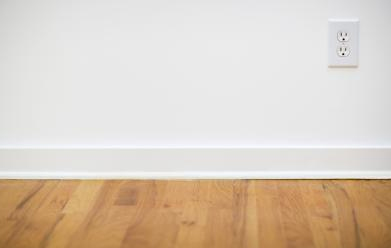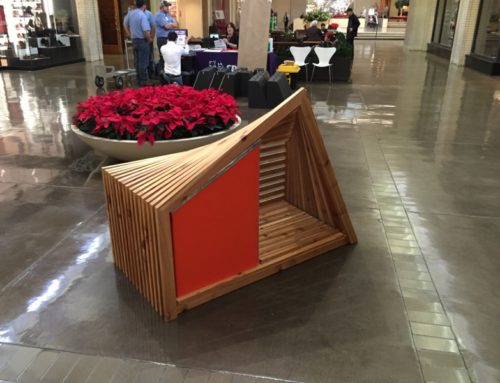Have you ever had a song stuck in your head (thanks, radio DJ) and it turned out to be an idea for your next blog post? Me neither until the other day. Modern architecture is about clean, crisp detailing and that includes things like the wall base.
What is a wall base you ask? It is simply the “trim” or “base” applied onto the wall surface at the floor level. In standard builder-grade construction (which isn’t necessarily modern in design) the wall base is usually a shaped piece of wood that is often painted. It will have curves, ins and outs, and is generally in place to hide the rough edges of the wall, the carpet, whatever.
In modern architecture, the wall base is often a place to emphasize the detailing of the house. Good architects generally match the wall base details to other details used in the house, like door jamb trims and even woodwork details on cabinetry. I will say that sometimes modern wall bases do exactly what their builder-grade counterparts do: hide the material edges behind the base. But in other examples, the wall bases are finely crafted and some really good detailing is expressed. Yep, you guessed it – this means modern wall bases can be more expensive than regular ‘ol moldings bought at the builder supply store. But in relation to the scheme of the whole house, a good base detail is a must for any modern or contemporary home.
What are some examples, you ask? Here you go, in no particular order! Because I’m all about that base, about that base……
 | | Base 1Flat, painted wood trim. Fairly simple in detail, but needs to be installed with care so paint is smooth and blemish-free. Bottom of base may need to be coped, or trimmed, to follow any inconsistencies in the flooring. |
 | | Base 2Double-stacked flat, painted wood trims. Builds upon Base 1 by adding a second, smaller painted wood trim above the main base piece. |
 | | Base 3Flat, painted wood trim. Also simple in detail, but needs to be installed with care because small wood trims have a tendency to bend if the wall isn’t straight. Your eye is naturally drawn to inconsistent patterns, and you will likely notice a “wobbly” base in a room. |
 | | Base 4Stained wood base trim. The stained wood adds cost over a painted base, but can be matched to the finish flooring to create a very integrated look. I would suggest restraint if you’re thinking to stain the base a different color from the floor – I haven’t seen successful examples of that attempt. |
 | | Base 5The small base reveal. Rather than adding a wood trim, an aluminum trim piece manufactured for this application is used to create a recess just above the floor. I know some builders consider this a hard detail to install – planning should be done ahead of time to make sure the base works with the wall thickness, floor thickness, etc. |
 | | Base 6The tall base reveal. Almost the same as the small version, could be up to 2″ in height before the wall surface starts. May require more wood framing so the wall board has something to attach to. If you’re going the reveal route, think about if you want it painted. I’ve heard that painting after installation is done can be tricky. |
 | | Base 7Combination of a flat, flush wood base with a reveal trim above. Very slick, very nice, very prevalent in some modern homes. As you are mixing systems this will inherently have more parts and thus more expense to budget for. |
 | | Base 8The no-base. AN L-shaped aluminum trim is installed at the floor level (so you don’t have the rough gypsum wall board edge slammed on the floor). Visually appears as a seamless wall rising up from the floor, slick indeed. It requires precision from both the installer and painter. And if you repaint later? Be ready to wipe paint off the floor or it appears poorly painted. |
 | | Base 9The stone or tile base. It is usually used where there is a stone or tile floor – excuse my rendering. This example shows a raw reveal trim above the base which gives the reveal a metallic finish straight from the box. If you want the reveal painted, you might speak with your builder about pre-painting it to save from lots of tedious clean-up. |
 | | Base 10Back to the reveal trim, this time not painted. I’ve seen this detail pulled off and when done well looks pretty crisp. I think it pairs nicely with an environment that has some stainless steel items as part of the design. |
 | | Base 11Painted, angled wood base. I threw this option in for good measure – not all modern wood bases applied to the wall surface have to be square! |
 | | Base 12Combination of a flat, flush wood base and no reveal. The joint between the base and wall is caulked and usually is the same color as the wall. You could omit the caulk and place the L-trim on top of the base. This would work great on interior walls but I caution you that for exterior walls lacking good air barriers, the crack invites air leakage into or out of the home. |
Because I’m all about that ba….Know of a common base that I left off? Post a comment for Eckxstudio!
Happy Thanksgiving!
____________________________
This post was originally written before re-branding as Eckxstudio for Modern Architecture at the end of 2017.
At Eckxstudio for Modern Architecture, we design unique and stunning projects, individually crafted for our clients’ lives. We’re passionate about listening to your needs, wants and desires as inspiration to design the dream home you’ll never want to leave.


















Leave A Comment